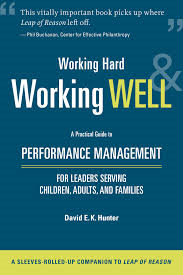What We’re Reading: Working Hard and Working Well by David Hunter
By Kelly Medinger
09-23-2014
A nonprofit’s guide for taking a successful “leap of reason” to sustained social impact
 This summer I spent some time at the University of Notre Dame in Notre Dame, Indiana working on my master’s degree. In my nonprofit management class, entitled “Leading for Social Impact,” we discussed the unique demands, expectations, challenges and opportunities of managing to success in the nonprofit context.
This summer I spent some time at the University of Notre Dame in Notre Dame, Indiana working on my master’s degree. In my nonprofit management class, entitled “Leading for Social Impact,” we discussed the unique demands, expectations, challenges and opportunities of managing to success in the nonprofit context.
As part of my class, I read Working Hard and Working Well by David Hunter. Described as “a sleeves-rolled-up companion to Leap of Reason,” Hunter’s book picks up where author Mario Marino left off by sharing how leaders, managers, staff, funders, and consultants can better understand and implement a performance management culture.
Some of you may remember my colleague Kathleen McCarthy’s review of Mario Marino’s Leap of Reason a couple years ago. His book is a call to action for nonprofits to make smarter decisions based on measurable outcomes. The premise is that many nonprofits don’t know whether they’re actually delivering on their promises. So instead of taking a “leap of faith” to achieve our mission, we should make a “leap of reason.”
Hunter follows Marino with the “how to” guide for making a successful leap. He says it’s all about becoming an organization that manages to performance. Performance management has struggled to take hold in the social sector, perhaps because of the top-down, command-and-control approach many managers take to making improvements. Hunter dubs this form of performance management “compliance management,” saying it’s better for driving activities, not results.
To articulate the recommended approach, Hunter outlines three pillars of performance management: performance leadership; management systems; and information and knowledge production. Related to the first pillar, an important distinction in Working Hard, Working Well is the difference between an operational leader and an operational manager. Operational leaders continually challenge the status quo, inspire others, and drive their concerns downward. Operational managers, on the other hand, align with the vision and priorities articulated by the leader, deploy resources to sustain excellence, and channel the leader’s concerns into productive work and high standards.
Reading this book, I learned that performance management is the relentless pursuit of “making it better.” Yet moving to this culture of continuous improvement is not an easy road. It means shifting perspectives: from data as a burden, to data as a useful tool; from functional program silos, to cross-functional teams; from fear of breaking rules and patterns to support for making mistakes and trying new strategies.
The point is that the world is (and probably will always be) messy and complicated. On top of that, social change is and will continue to be even messier and more complicated. But there are tools we can all use to respond and be ready – strategic clarity and measurable outcomes being among them. With these tools in hand and Hunter’s road map for performance management, we can all hold hands and take a “leap of reason” toward greater impact by working hard and working well.
